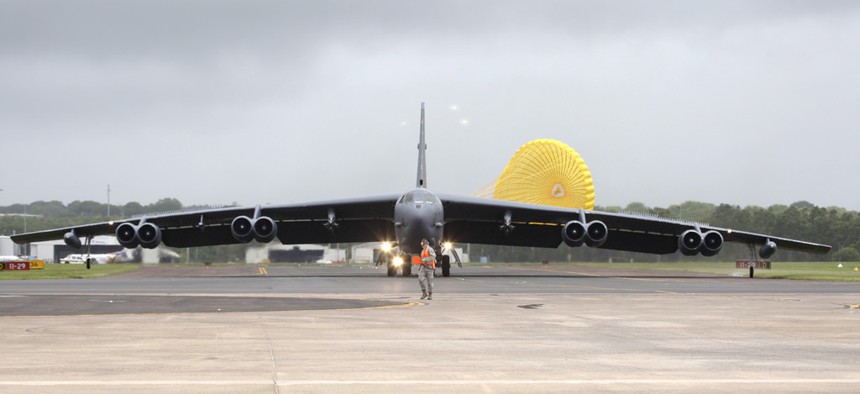
A B-52 Stratofortress lands at Royal Australian Air Force Base in Darwin, Australia on January 28, 2014. Australian Department of Defence photo
Congress Says Pentagon's Long-Range Bombers Are 'Increasingly Irrelevant'
Congress sounds the alarm on America's aging bomber fleet: fix them up or put them to pasture. By Rachel Oswald
A new congressional report highlights the potential for a shortfall to emerge in the Air Force's ability to mount long-range nuclear bomber attacks.
A Congressional Research Service report published online on Saturday highlights a number of factors that could result in a gap in the country's ability to conduct long-range nuclear strikes by air, among them foreign nations' development of sophisticated anti-access and area-denial capabilities and reductions in defense spending imposed by the 2011 Budget Control Act.
The Pentagon is planning on building a new long-range stealth bomber, but the first units are not expected to become available until the mid-2020s. In the meantime, the ability of the Air Force's current fleet of nuclear-capable bombers "to get close enough to targets to employ weapons will likely continue to deteriorate" as potential adversaries acquire more advanced air defenses, according to the report by Congress' internal think-tank.
"Already, against today's toughest air defenses, the B-52 and B-1 are largely regulated to standoff roles; only the B-2 is expected to get through," states the report by analyst Michael Miller. "In the years to come, the Air Force anticipates the B-2's ability to penetrate will also decline, even though the Air Force plans to upgrade all three bombers with new systems and weapons."
Not much is publicly known about the envisioned characteristics of the next-generation bomber, including what capabilities it will be given to defeat opponents' anti-access weaponry. The Air Force wants to buy between 80 and 100 new bombers.
Much has bee written in recent months and years about the potential for China's growing arsenal of cruise and ballistic missiles to inhibit the ability of the U.S. military to project naval power in the Asia-Pacific.
There are approximately 157 long-range B-52s, B-1s and B-2s in the U.S. arsenal. The Defense Department plans to maintain a bomber fleet of roughly 156 aircraft through at least 2022, the report notes. However, the nearly $500 billion in congressionally imposed defense cuts that are to be implemented over the next decade, as well as the potential for further military cutbacks, could impact the size of the Air Force's legacy dual-capable fleet, according to Miller.
The reduced military budget comes as Pentagon spending on its nuclear bombers is projected to double by fiscal 2020 to over $9 billion annually, thanks to the cost of acquiring the new long-range bomber and installing upgrades to the B-52, B-1 and B-2 at the same time. Current service modernization plans are designed to keep the former two planes "operational" through 2040, and the B-2 deployable through 2058.
The CRS report flags for Congress' oversight attention the question of whether to continue to pay for "sustainment and modernization efforts" for legacy bombers in the face of potential adversaries' growing air defense capabilities, or to alternatively allow the bombers to "become increasingly irrelevant."
"In large part, decisions by Congress will determine just how much longer the B-52, B-1 and B-2 will remain relevant, and ultimately, will likely determine the future of the nation’s long-range strike capabilities," the document reads.
NEXT STORY: Who Should Replace Shinseki?




